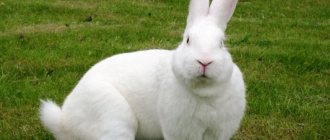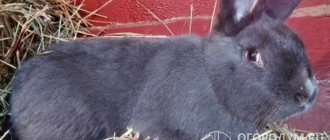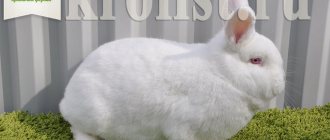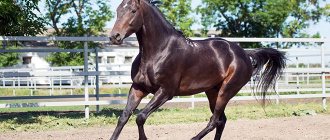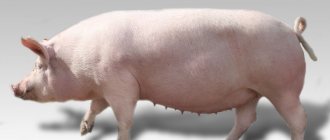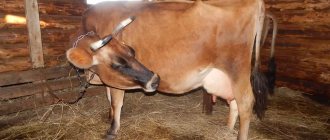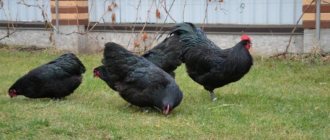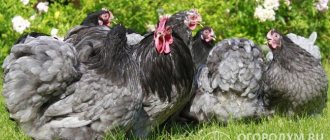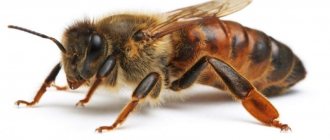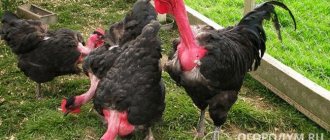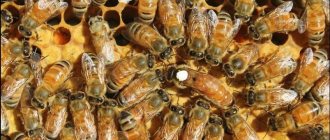The Wyandotte chicken breed appeared back in the 19th century, in the United States of America. Chickens got their name thanks to one Indian tribe, which used in their ritual actions the same colors as the newly bred chickens.
Selection work on the creation of this bird continued for a long period of time and by 1883 a new breed of chickens was born - the silver Wyandotte. To breed this bird, scientists had to cross:
- Orpingtons.
- Leghorn.
- Bram.
- Kokhinkhinov.
- Dorkings.
- Bentham Seabrights.
As a result of such selection, a very promising breed for that time was born. The new chicken had excellent egg production, gained weight very quickly and produced high-quality meat products.
Initially, the breed was not named as such. And Seabrights, and Excelsior, and Colombian chickens. But ultimately it received the name that has survived to this day.
The breed was brought to Russia in the 20th century, in 1911. As noted earlier, the original Wyandotte is gray. However, scientists from different parts of the world were engaged in breeding work on this bird, as a result of which about 15 variations of Wyandotte colors were obtained.
And in today’s publication you will find a detailed description of representatives of this breed, see photos and reviews of poultry farmers who were lucky enough to meet this chicken.
Appearance
Representatives of this breed have a massive body and a small head with a pink crest. Earrings and earlobes are bright red. The eyes, like most chickens, are red-orange.
The neck is strong and fairly short. There are no clear colors of the beak and metatarsus, as they vary depending on the color of the Wyandotte and can be either light yellow or dark gray.
The rooster's body is more vertical and located at a slight angle to the surface, while the laying hens look more spherical.
The back and lower back of both hens and cockerels are straight and wide. The chest is well developed. The tail is quite short, but at the same time fluffy and beautiful.
The weight of an adult rooster reaches 4 kg, while laying hens are an order of magnitude lighter and weigh no more than 3 kg.
Chicken Temperament
This beautiful bird is friendly and gets along well with people. Chickens are easily tamed, having gained the experience of affectionate and patient communication with humans from a young age. They are magnificent hens and reverent mothers.
Despite its peaceful disposition, Wyandotte has a bright personality and in a mixed flock of poultry, chickens tend to dominate their companions of other breeds and species. Roosters are generally peaceful, but will tirelessly defend their harem and territory from the encroachments of strangers.
Chickens are somewhat noisy and like to loudly discuss everything that happens.
At the same time, this is an incredibly positive bird that will decorate any yard and add a touch of homeliness and comfort. Wyandotte chickens and rooster
Color options
As noted earlier, Wyandottes have a wide variety of colors, ranging from blue to golden.
The most popular is the classic option - gray. Representatives of this species have a white feather with a silvery tint, and at its ends there is a clear black edging. This variety is the most popular among breeders.
In addition, there are other varieties:
- Golden-edged.
- Partridge.
- White.
- Black.
- Dark yellow.
- Colombian.
- Lavender.
- Silver-outlined.
- Red-lavender edged.
- Cuckoo.
In addition to these colors, there is generally another variety - the dwarf Wyandotte. It is not difficult to guess that representatives of this species have smaller body dimensions than those of the classic Wyandotte.
Dwarf Wyandotte hens weigh no more than 1 kg, while the body weight of cockerels reaches 1.5 kg. Representatives of the dwarf breed have more color options than the classic ones and reach 28 colors.
Dwarf Wyandotte
A miniature variety of Wyandottes was bred by breeders from England. This ornamental bird is a smaller copy of the American line. The weight of an adult rooster is 1 kg, and the weight of a laying hen is 100–150 g less. The dwarf variety has the same beautiful and voluminous plumage. Chickens lay 100–120 eggs per year, each weighing 34–38 g.
Those who are looking for a suitable breed of chickens for breeding at home should get to know the Wyandottes better. These are very beautiful, calm, unpretentious birds that produce excellent meat and a lot of eggs. There are never any problems with them, as evidenced by reviews from farmers.
Productivity
One of the main disadvantages of the breed is the late laying period. Previously, there was no emphasis on early maturity, so this indicator was largely ignored. As a standard, Wyandots begin to produce eggs only at 6-9 months of their life. This characteristic, naturally, completely excludes the use of laying hens on poultry farms.
The productivity of chickens is in the average range. In a year, under favorable conditions, a bird can produce up to 200 eggs.
The eggs weigh about 60 grams, the shell is of medium density, of different colors, depending on the type of breed.
In terms of meat, everything is a little better. The young animals gain weight very quickly. The meat of this breed of bird is tasty and juicy.
History of selection
The Wyandottes were bred by Indians living on the North American continent. The line was created over several years. The following breeds participated in the selection:
- gate;
- Orpington;
- leghorn;
- Dorking;
- Cochinquin;
- Seabright bantams.
As a result of this mixing of breed lines, a universal chicken was born, distinguished by its attractive appearance, high egg production rates and excellent meat quality. The first variety of Wyandot, the silver one, was registered in 1883. A year later, representatives of the breed came to Europe. Breeders from different countries worked to create new types of colors for American chickens. Today there are more than 15 of them.
Reference. The chickens got their name from the Indian tribe of the same name in which they were bred. Throughout its existence, the breed has been renamed more than once. It was called Colombian, Excelsior, Seabright.
Russian farmers became acquainted with the meat and egg line of American origin at the beginning of the 20th century. She immediately attracted the attention of private farm owners. The bird has a luxurious appearance and provides the owner with a large number of eggs and meat. Wyandottes are still popular in our country.
Advantages and disadvantages of the breed
The chicken has a very attractive appearance, but few people use this bird only to decorate their private yard. Chickens must have qualities to attract the attention of poultry farmers. Among the main advantages of Wyandotte are:
- Low temperature resistance.
- Stable performance throughout all periods of the year. Chickens do not stop laying eggs even in winter.
- High survival rate of young animals. Of the chicks that are born, about 98% survive to adulthood.
- Chickens have a friendly and calm nature, which allows them to be kept with other poultry.
- Wyandottes are a source of tasty, juicy and very healthy meat.
Are there any disadvantages? Unfortunately yes. And most of these shortcomings have given the chicken a not very good reputation, which is why it is not used for breeding on an industrial scale:
- This is a rather “lazy” chicken that leads a sedentary lifestyle. Because of this, the breed is prone to gaining fat mass.
- Almost no one raises these chickens, so the breed is quite rare and expensive. Against the backdrop of the emergence of modern crosses, their popularity has decreased even more.
- Finding purebred representatives of this breed is very difficult, and in some places impossible.
- Hens lay their first clutch very late, at approximately 6-9 months. In addition, egg production in Wyandottes is not high enough.
Breeding
Learning to breed Wyandottes is not easy. In this case, the breeder faces a number of problems:
- It is necessary to master the skills of breeding the required colors, in addition, take into account that selection is fixed on both the paternal and maternal lines. To do this you need to use a color calculator. But it only gives an approximate direction, since there are many hybrids of this breed.
- Breeders recommend avoiding the possibility of obtaining inbrids (crossing within the population), this reduces immunity, egg production and spoils the exterior. This is not easy to do, given that only two lines of Wyandottes are common in Russia - from Poland and from Germany.
- Buying a hatching egg - standard and dwarf eggs differ little from each other in color and size.
- Buying young chickens - the colors of newly hatched chicks can be quite varied. What color an adult bird will be can be found out only after the first molt.
Wyandottes are bred on farms to preserve genetic material for breeding crosses.
Removal methods
Chicks are hatched both in incubators and naturally. In this they are no different from other breeds of chickens; there are no special requirements for the process.
Eggs selected for incubation must weigh at least 55 g and have a smooth and undamaged surface. They should be stored for up to 14 days in a cool place.
During natural incubation, so many eggs are placed under the chicken so that they are completely hidden under it in one layer. The hen will hatch them for 20-21 days. And then, she will take on the responsibilities of caring for the chicks. All that remains for the breeder is to provide the necessary food and clean water on time.
When incubator breeding, the following sequence is followed:
- the incubator is heated to 25 °C (this is considered room temperature);
- the eggs are brought into the room in which the incubator is installed so that they warm up to the room temperature;
- the eggs are placed in the incubator and the temperature is set to 39 °C;
- on day 12 the temperature is reduced to 38.5 °C;
- from the 19th day until hatching (20-21 days) the temperature is maintained at 37-38 °C.
Once hatched, chicks should be kept in a brooder and the temperature controlled. Or you can put it on a hen, if you have one (the chicken can be of any breed).
From 2 weeks of age, chicks are placed on open grass for 15-20 minutes. You can equip a covered, draft-proof enclosure specifically for young animals. It is important that the walking area has both sun-warmed and shaded areas. Walking time is increased gradually.
After fledging, the chickens are transferred to a common chicken coop, but the roosting area must additionally be heated using an infrared lamp if the young are raised without a hen.
Chickens are fed boiled eggs mixed with semolina or starter feed until they are one month old. Afterwards, add herbs, dairy products, mixtures of meat and fish waste.
Maintenance and care
The growth rate of Wyandotte chickens is similar to that of broiler breeds. Young animals also quickly gain weight. However, maximum results can only be achieved under favorable conditions, and it does not matter how unpretentious the Wyandotte breed is.
If you are planning to start raising poultry, then you need to pay attention to such nuances as:
- Ventilation of the room. The chicken coop should be well ventilated, but at the same time free from drafts. Drafts cause chickens to get sick. But ventilation allows you not only to saturate the room with fresh air, but also to remove unpleasant odors, in particular, due to poultry waste.
- The chicken coop should be well lit, especially in winter. In winter, daylight hours are greatly reduced. If no measures are taken, the chickens will begin to lay eggs worse. Therefore, additional lighting is organized in the chicken coop, using ordinary “yellow” incandescent lamps.
- Additional flooring is provided on the floor in the chicken coop. Peat, sawdust, straw or hay are used as flooring materials. The height of the flooring should be at least 15 cm. It is changed every 3-4 months.
- Every six months (ideally) the premises should be disinfected. It is necessary in order to rid the chicken coop of parasites such as ticks and fleas. They, in turn, cause significant harm not only to the chickens themselves, but also to their owner when he enters the room to clean it, or to pick up eggs.
- Three feeders are installed in the room. Food is poured into one, water is poured into the second, and wood ash is poured into the last. Wood ash is necessary so that chickens can clean their feathers and get rid of harmful parasites. It is advisable to place feeders along the wall so that birds cannot knock them over. Also, to prevent chickens from fussing around in food or water, poultry farmers recommend installing nets on them that will not limit access to food, but will protect it from the bird’s paws and from its droppings.
- The chicken coop should also have perches and nests built. The nests should be quite spacious, approximately 40x40 cm. It is best to make perches of the ladder type. On roosts, hens should have at least 20 cm of their own space.
- Wyandots live well in unfavorable climates. However, if the winter is cold, it is still best to insulate the chicken coop or use heating in it.
Possible diseases
The birds are in good health. The most common diseases include:
- Parasitic infestations most commonly affect Wyandots. Therefore, it is necessary to avoid contact with other animals and birds and regularly disinfect the house and nests.
- Arthritis – can develop due to dampness in the chicken coop. To prevent this, you should monitor the litter, change it promptly, especially if it is damp, and provide good ventilation.
- Infectious diseases most often affect young individuals. Preventive measures should be followed and vaccinations should be carried out in a timely manner.
Read about other chicken diseases here. Chicks are most vulnerable to various diseases up to 10 days old, after which their health improves.
Diet
It is very important for chickens to receive a balanced diet. In order for Wyandottes to develop well and have the best productivity indicators, their diet must include:
- Cereals. It is advisable to give them in the morning and evening. Grains make up at least 50% of the chickens' total diet.
- Sources of calcium. The most common sources of calcium are chalk, crushed shell rock and ground eggshells. Speaking of shells, this is a good source of calcium, but it must be used carefully, since the chicken may recognize it as an egg, and this, in turn, will provoke further pecking of its own eggs. Chalk is also not the best source of calcium, since with its constant use it can stick together, which will cause clogging of the gastrointestinal tract.
- Mash. Mash is an excellent addition to the diet. It is best to give mash at lunch. The mash is ideal because it contains a large amount of substances necessary for poultry. They can be cooked either in meat broth or in plain water.
- Fresh greens. Is an excellent addition to the diet. Fresh greens help reduce feed costs, making keeping this chicken more economical.
With all this, you need to understand that chickens of this breed are quite voracious. If you do not control their diet, you may end up with the bird becoming obese.
Where can I buy? Price
It is better to purchase Wyandottes from specialized nurseries. The following have worked well:
- Moscow region, Mytishchi, st. Border dead end, house 4. “Orlovsky courtyard”.
- Moscow region, Balashikha. "Kingdom of Chickens"
The price of a hatching egg is 40-50 rubles. a piece.
An adult rooster of standard size can be bought for 500 rubles.
An adult chicken – about 400 rubles.
Breeding Wyandottes in Russia is not very profitable due to the high price of breeding birds that are brought from abroad, but if you organize activities in this direction, you can make a good profit, since chicks and hatching eggs can be sold at a high price. In addition, the Wyandots are able to provide the farm with high-quality meat and eggs.
0
0
Copy link
Character
The temperament of these feathered beauties is also worthy of admiration. They are incredibly friendly, peaceful, and calm. They can find a common language in any group, and are equally friendly towards both representatives of their own breed and completely different types of poultry.
They can share a walking yard with geese, ducks, turkeys and other residents of the owner's yard. Chickens are not timid - they are difficult to scare. On the contrary, they very quickly get used to their owners, are given into the hands and respond to a person’s call.
conclusions
- Wyandotte and Redbrough are a hybrid breed of chickens for meat and eggs, bred by American breeders in the mid-19th century.
- This breed is distinguished by its unique appearance and demonstrates good productivity indicators.
- There are many subspecies of Wyandotte chickens, including the dwarf chicken, which is exclusively egg-producing.
- Keeping Wyandottes differs from the usual breeds of poultry in terms of the food supply, as well as the need for constant monitoring of the cleanliness of the chicken coop.
Feeding
A balanced diet for the Wyandotte chicken breed will ensure their proper development and maintain the health of the chickens in the future.
When high protein feed is introduced into their menu, chickens grow and gain weight quite quickly.
So, the diet of birds often consists of the following components:
- mixtures of vegetables such as potatoes, beets, carrots and zucchini;
- fresh grass, greens in summer and ground hay in winter;
- grain mixes from corn, millet, wheat and oats;
- vitamin and mineral preparations;
- bone, fish meal;
- chalk, sand.
Regarding vitamin and mineral complexes, it is worth noting such mixes for laying hens as: Felucen for chickens and Chiktonik solution. In addition, a peculiarity of feeding Wyandottes is that it is forbidden to overfeed them, since birds in general are prone to obesity.
Temperature
Wyandotte chickens (photo and description attached to the article) feel good at outside temperatures of 16 to 18 degrees. If the temperature drops, more calories supplied with food are spent on heating the body, and less is left for egg and meat production.
In cold weather, all the energy of the feed is spent on heat production. Chickens do not have sweat glands, so they do not tolerate heat well. The bird protects itself from overheating by reducing feed consumption and drinking more water. In hot weather, poultry farmers add anti-stress drugs to their drink.
Imperfect thermoregulation of chickens is caused by the lack of feather cover. The hen prevents the chicks from freezing or overheating. When a poultry farmer incubates eggs, he must comply with the requirements presented in the table.
Young animals older than a month regulate their body temperature on their own and do not need to be kept under a brooder.
